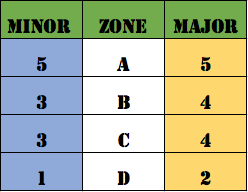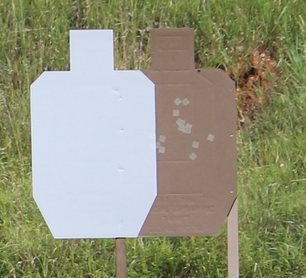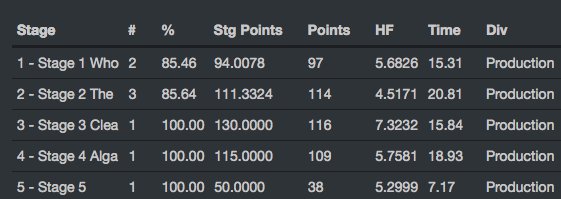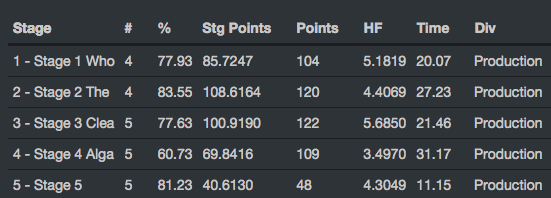Who in the heck is Charlie Mike?

Left: Metric Target Right: Classic Target
When I started shooting USPSA, I followed the range officer (R.O.) around while pasting targets, and tried to understand the scoring. Needless to say, eventually the rat on the wheel in my head had to stop for a cheeseburger, and a nap.
Below is an easy to understand guide for scoring in USPSA shooting:
The Big Picture: The easiest way to understand the scoring in USPSA is what is referred to as “Hit Factor.” Which sounds like something from the movie Bloodsport, not a shooting competition, but it is really simple.
- Hit Factor is simply your points divided by your time. The highest Hit Factor wins the stage.

Not That Hit Factor
Hit Factor = Points ÷ Time
How Point Scoring Works: Points are granted to the shooter for every shot that impacts the target. The closer you are to an “A” zone hit, the higher the point score value. The further away from the “A” zone that the shooter hits, the lower the points awarded to the shooter. Points are subtracted from the shooter for missing the target or hitting “No Shoot” Targets (we will get to this below).
- Each shooter can choose to compete in two different categories, called “Power Factor.”
Power Factor = Bullet in grains x Velocity in FPS ÷ 1000
Most of the time, 9mm shooters will be in Minor Power Factor, and .40 S&W and up will be shooting in Major Power Factor. However, because Power Factor is based on the way the ammunition is loaded, there are always exceptions to that rule. Therefore, it is easy to measure your Power Factor. Below is the measuring stick for Minor vs. Major Power Factor:
- Minor Power Factor = at least 125
- Major Power Factor = at least 165

How Harry Callahan does Major Power Factor
Example of Minor Power Factor Ammo: Typical 9mm practice ammo would be something like: 115gr bullet traveling at around 1100 fps.
Power Factor = 115 x 1100 ÷ 1000 = 126.5
Therefore, this jut barely makes the minimum of 125 Minor Power Factor. Below 125 PF, and you would not be allowed to shoot a match or you can shoot, but your score will not be eligible to compete. I wouldn’t want to cut it that close, because in certain matches, if they shoot one of your rounds through a chronograph (which they will do at certain matches) and it doesn’t make PF, then you can’t shoot the match.
Example of Major Power Factor Ammo: Typical 40 S&W practice ammo would be something like: 180 gr bullet traveling at around 950 fps.
Power Factor = 180 x 950 ÷ 1000 = 171
Therefore, this ammo would reach Major Power Factor because it is greater than the 165 PF minimum.
So don’t just keep Power Factor in mind when scoring, but also when purchasing ammo, and when registering for the match.
Major and Minor Power Factor Scoring:

Therefore, to get your points you simply add up the number of shots in each zone, and multiply by the appropriate points for each hit for either Major or Minor PF.
In case you haven’t figured it out from being at a match yet, the zones are most often referred to as “A” = Alpha; “B” = Bravo; “C” = Charlie; “D” = Delta; “Miss” = Mike.
* Edit: there is no longer a Bravo scoring zone on USPSA targets. The “B” zone is now part of the “C” zone. However, because it has been around since the beginning of the sport (and is contained in much literature), we left “B” zone scores in this article. Some clubs that purchased bulk packets of targets will still have a “B” zone targets, so it’s good to know. Just score any hits in a Bravo zone as a Charlie hit.
**Note that if any portion of the bullet hole created as a result of your shot touches the line dividing two zones, then you get the benefit of the higher score. So if any portion of the bullet hole is making contact with the outside of the perforations of the “A” zone, then it is scored as an Alpha. This rule also applies to No Shoot targets as well (No Shoots are discussed below), so don’t touch the perf on a No Shoot or you’re down 10 points.
How Your Time Works: This is probably not something that you need explained, but the time for your stage begins when the buzzer sounds, and ends when the last shot is fired, which is registered from a shot timer. This is your time from the stage.
Scoring Example: Below is a video of an a Classifier stage (called “Tick Tock”) that I shot in my 2nd match. If you listen closely, you can hear the Range Officer (R.O.) calling out “4…4…4..and 4” meaning 4 Alphas. Then the guy doing the scoring says the time (16.07 sec., then the HF of 4.978). I’m new so please don’t judge, but the scoring is as follows:
80 points (16A x 5 pts each) ÷ 16.07 = Hit Factor of 4.978
Steel Targets: Steel is the most simple to score. If you knock it over, it is scored as an “A” Zone hit. If it is left standing after you shot at it, then it counts as a miss, so shoot till the steel falls!
Steel may take the form of a “popper”, a round or square plate, or Texas Star, etc. It is all scored the same.
Mikes & No Shoots: If you shoot USPSA long enough, it will happen to you. The name you never want to hear the RO call…. “Mike!” or “No Shoot!” Mikes (a/k/a Misses) are counted as a -10 points per occurrence. No Shoot Targets (sometimes called Hostage Targets) will also get you a lovely -10 per dead hostage.

See the white No Shoot Target On the Left
So, if you are shooting a stage, and fire two shots at a target, and one shot hits in the Alpha zone, and the other hits a No Shoot Target, you would get a +5 for the Alpha, then -10 for the Mike, and another -10 for hitting the No Shoot = so you are at -15 points on that target. So generally speaking if you call the shot as a miss, or see that you’ve hit a No Shoot, then you should try to clean that up by making a solid “A” zone hit on the target before moving on to the next target.
Procedurals:
You can get a procedural for a variety of reasons. Things like taking a shot while stepping over a fault line, shooting more than the prescribed number of shots, failing to engage a target, etc. A Procedural mistake will land you -10 points for each occurrence. Just follow the stage plan for each stage, and keep your mental game sharp, and you will avoid these penalties.
- Think of it this way….Procedurals could be referred to as paying the “Brain Fart Tax.”
Stage Points & Match Points:

STAY WITH ME, GOOSE!
When you Shoot a match, you will notice that each stage in the match has a total number of points. Whoever wins that stage by achieving the greatest Hit Factor (i.e. has the best points ÷ time), will be awarded 100% of the points for that stage. Each shooter that places under the winner of the stage will be awarded points based upon how their Hit Factor scored in relation to the stage winner’s Hit Factor. STAY WITH ME GOOSE! I know this is the most jacked up way to score something, but just hang in there. It will all make sense one day. Like all that time your dad spent in the bathroom…(Psst, spoiler. He didn’t have IBS. It was just to get away from you!)
For example: Look at the match results for the guy who won the match in Production Division. Specifically, lets look at Stage 5:

Match Winner’s Match Results

Mall Ninja Match Results
- If the total points for a stage is 50 points. The the winner of the stage will collect 50 points. He shot 38 points in 7.17 seconds. Thus, 38 ÷ 7.17 = 5.299 Hit Factor.
- Mall Ninja shot the same stage, but you shot 48 points in 11.15 seconds (thanks to a botched reload & dropped mag, but I digress) having a HF of 4.3049.
- Mall Ninja would take his HF and divide it by Match Winner’s HF (4.3049 ÷ 5.2999 = 0.81226), and that would give Mall Ninja 81.23% of the available stage points (this happened to be 5th place in this particular match).
- You would add up all of a shooters stage points for each stage. Whomever has the highest number of stage points for the day wins the match!
Whew! If you’ve made it this far, you’re either Rainman or you deserve a victory taco or something. I know at first all of the above seems to make as much sense as a football bat, but it really isn’t that bad once you shoot a match or two. When you’re shooting a match, just shoot Alphas as fast as you can see the sights, and worry about the scoring later. Chances are the club that you shoot at will use a system that automatically scores you once all of the information is fed into a tablet, so you don’t have to do all this math for yourself or anything.
Good Shooting, and comment below if I left anything out. Please let me know if you found this article helpful in any way, or if you have any other topics you may wish to discuss.
Categories: Shooting
This is a really good read! I recently created a video on Hit Factor specifically, but I’ll use this as a reference for overall USPSA scoring.
LikeLike
Thanks Jabari. I hope it was helpful.
LikeLike